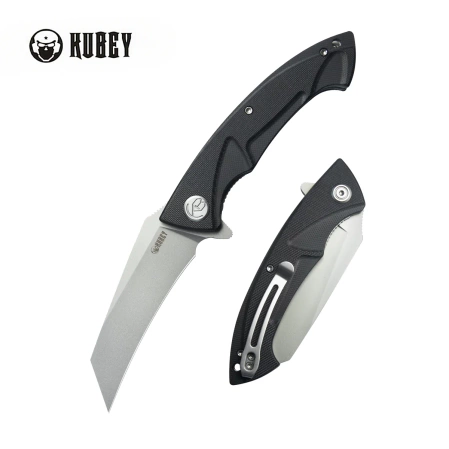Kubey Anteater Knife Black G10, Sandblasted 14C28N (KU212I)
- Anteater Black G10, Sandblasted, large universal EDC folder. Blade of hawkbill type made of Sandwik 14C28N steel, comfortable G10 composite handle. Quick opening with a flipper, liner lock. Excellent value for money! Bestseller!
Anteater Black G10, Sandblasted is a versatile EDC folder that impresses with its precision craftsmanship and reliability. Blade with hawkbill profile, made of durable Sandvik 14C28N steel, corrosion resistant and easy to sharpen. The contoured G10 composite handle guarantees a secure grip and comfortable use, even in demanding conditions. The quick flipper opening mechanism is designed to make the movement smooth and precise. A solid liner lock ensures safety during use. The model stands out for its excellent value for money, making it an ideal choice for those looking for a reliable knife for everyday use. Valued by users - a true bestseller.
Kubey - an independent brand and one of the largest manufacturers producing knives of excellent quality at a great price! The motto of the company is “An Edge Above the Rest” / “Blade above all”. Through the use of high-speed CNC machine tools, milling machines, laser cutting or custom hand finishing, the brand relies on high quality workmanship and an innovative approach to design. Kubey stands for legendary durability and functionality in knife tools that will last for years!
14C28N - martensitic chromium stainless steel is the latest development in a range of knife steels produced by Sandvik's Swedish mills. An optimized chemical composition with a unique combination provides superior quality, excellent edge performance, high hardness and corrosion resistance. By reducing the amount of carbon 0.62% (C) and increasing the chromium content 14.0% (Cr), as well as adding nitrogen 0.11% (N), corrosion resistance has been significantly improved. Considered an improved version of 13C26 steel. Unbeatable in the price/quality category!
Blade - resembling the claw of a bird of prey, hawkbill type, finished masking minor scratches from use using Sandblasted method. The curved cutting edge converges towards the tip of the wedge. The thickness of the wedge, combined with a high, flat grind, results in excellent cutting edge geometry and extreme cutting performance. Ceramic ball bearings are responsible for the smooth and smooth operation of the mechanism and support the opening of the blade with the index-finger flipper when opened acting as a stag. On the back of the upper jimping wedge, a notched thumb rest. Liner-Lock mechanism.
Handle - grips made of G10 composite, a material extremely mechanically durable and practically completely resistant to weather and chemicals, textured to improve grip confidence, screwed to the knife' s steel frame. The so-called open-backed design without the typical backspacer, fastened together with steel spacer sleeves for easy cleaning. The simple, secure design gives assurance of many years of use. A fore finger groove improves grip security. The pivot axis is decorated with a stylized screw. A single-position (right) metal deep-carry clip allows you to carry the knife discreetly in your pocket in tip-up position (blade tip up).
Technical data:
Product number: KU212I
Product name: Anteater Black G10, Sandblasted
Overall length: 204.0 mm / 8.03”
Blade length: 87.0 mm / 3.42”
Blade thickness: 3.1 mm / 0.12”
Handle length: 117.0 mm / 4.6”
Handle thickness: 15.0 mm / 0.59”
Weight: 129.2 g / 4.55 oz
Blade material: Sandwik 14C28N
Blade hardness: 60-62 HRC
Blade grind: Flat
Blade finish: Sandblasted
Handle material: G10
Handle finish color: Black
Backspacer material: Stainless Steel
Backspacer color: Gray
Clip: Right, Tip-Up
Clip material: Stainless Steel
Pivot mechanism: Caged Ceramic Ball Bearing.
Locking mechanism: Liner Lock
Opening method: Manual, flipper
Additional accessories: n.d
Designer: Kubey Knife Team
Brand: Kubey Knife
Manufacturer: Kubey Knife
Country of origin: P.R.C.
Developed by: the Sharg® company
Przeczytaj!
This product is intended for use only by adults with knowledge and experience in handling sharp cutting tools. Improper use of the knife can result in serious injuries. The blade is extremely sharp and can easily cut through skin and tissue; therefore, extra caution should always be exercised while cutting, and hands should be kept away from the cutting edge. To prevent the knife from slipping, it is recommended to cut on a stable, non-slip surface and avoid excessive force, which may cause uncontrolled blade movement.
Leaving the knife on the edge of a table, countertop, or in easily accessible places—especially where children are present—poses a significant safety risk. The knife should always be properly secured after use, ideally by placing it on a stable surface or storing it in designated knife blocks, protective sheaths, or magnetic strips. The knife should never be used for tasks it is not designed for, such as opening cans or prying objects, as this can damage the tool and lead to dangerous accidents.
A dull blade increases the risk of injury, as it requires more force and is more likely to slip from the material being cut. Therefore, it is essential to sharpen the knife regularly to maintain optimal sharpness. Additionally, proper cleaning and drying of the knife are necessary to prevent corrosion and bacterial growth. Periodic inspection of the handle and blade is recommended to check for cracks, chips, or looseness. If any damage is detected, the knife should be repaired or replaced immediately.
When using the knife, focus solely on the task at hand—avoid talking on the phone, watching television, or other distractions while cutting. Ensure proper lighting in the workspace for better visibility and control. Please note that some countries or regions have laws restricting the ownership and carrying of knives. Before purchasing or using this knife, verify that its use is legal in your location according to applicable regulations.
Following these safety guidelines will help ensure safe and effective knife use, minimizing the risk of accidents and extending the lifespan of the tool.


